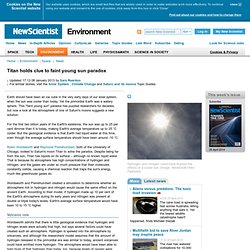

We need more TEA Party patriots in Congress!
Finding Candidate Planets. Universe. Jupiter. Titan holds clue to faint young sun paradox - environment - 04 January 2013. Earth should have been an ice cube in the very early days of our solar system, when the sun was cooler than today.

Yet the primordial Earth was a watery sphere. This "faint young sun" paradox has puzzled researchers for decades, but now a look at the atmosphere of one of Saturn's moons suggests a new solution. For the first two billion years of the Earth's existence, the sun was up to 25 per cent dimmer than it is today, making Earth's average temperature up to 25 °C colder. But the geological evidence is that Earth had liquid water at this time, even though the average surface temperature should have been around -10 °C. Robin Wordsworth and Raymond Pierrehumbert, both of the University of Chicago, looked to Saturn's moon Titan to solve the paradox. Wordsworth and Pierrehumbert created a simulation to determine whether an atmosphere rich in hydrogen and nitrogen would cause the same effect on the ancient Earth.
Volcanic role Raindrop enigma Journal reference: Science, doi.org/j47. Pulsar experienced tremendous hiccup during fastest rotation. Washington, Wed, 25 Jul 2012 ANI Washington, July 25 (ANI): Max Planck scientists have discovered a young and energetic neutron star with an unusually irregular rotation.

Pulsars are superlative cosmic beacons. These compact neutron stars rotate about their axes many times per second, emitting radio waves and gamma radiation into space. Using ingenious data analysis methods, researchers from the Max Planck Institutes for Gravitational Physics (MPG) and for Radio Astronomy (MPIfR), in an international collaboration, dug a very special gamma-ray pulsar out of data from the Fermi Gamma-ray Space Telescope. Wormhole. A wormhole, officially known as an Einstein–Rosen bridge, is a hypothetical topological feature of spacetime that would fundamentally be a "shortcut" through spacetime.

A wormhole is much like a tunnel with two ends each in separate points in spacetime. Astronomy. Bacterial explanation for Europa's rosy glow - 11 December 2001. The Universe. Space. Space. KSP. News and information about meteor showers, solar flares, auroras, and near-Earth asteroids. Galactic astronomy. News and information about meteor showers, solar flares, auroras, and near-Earth asteroids. The Great Filter theory suggests humans have already conquered the threat of extinction. Life on other planets could be far more widespread, study finds. (Phys.org) —Earth-sized planets can support life at least ten times further away from stars than previously thought, according to academics at the University of Aberdeen.

A new paper published in Planetary and Space Science claims cold rocky planets previously considered uninhabitable may actually be able to support life beneath the surface. The team, which included academics from the University of St Andrews, challenge the traditional 'habitable zone' – i.e. the area of space around a star, or sun, which can support life – by taking into consideration life living deep below the ground. "The traditional habitable zone is also known as the Goldilocks zone," explains PhD student Sean McMahon. "A planet needs to be not too close to its sun but also not too far away for liquid water to persist, rather than boiling or freezing, on the surface.
Future evidence for extraterrestrial life might come from dying stars. (Phys.org)—Even dying stars could host planets with life—and if such life exists, we might be able to detect it within the next decade.

This encouraging result comes from a new theoretical study of Earth-like planets orbiting white dwarf stars. Researchers found that we could detect oxygen in the atmosphere of a white dwarf's planet much more easily than for an Earth-like planet orbiting a Sun-like star. "In the quest for extraterrestrial biological signatures, the first stars we study should be white dwarfs," said Avi Loeb, theorist at the Harvard-Smithsonian Center for Astrophysics (CfA) and director of the Institute for Theory and Computation.
Search for extraterrestrial intelligence. Hubble Heritage Gallery of Images - StumbleUpon. THE TRUTH BEHIND THE SCENES. Search For Life. The Known Universe Mapped. Astrophysics. Cosmic latte. Cosmic Latte is a name assigned to the average color of the universe, given by a team of astronomers from Johns Hopkins University.

Discovery of the color[edit] Extraterrestrial life. Outer space. Learn More at Space.com. From Satellites to Stars, NASA informat. Outer Space Flight Videos & Pictures. Life on Mars found but destroyed by mistake - Sci/Tech. Bungling NASA scientists are believed to have found tiny live microbes on Mars - but mistakenly killed them by boiling them alive, a media report said.

Bungling NASA scientists are believed to have found tiny live microbes on Mars - but mistakenly killed them by boiling them alive, a media report said Saturday. Two spacecraft that landed on the Red Planet in 1976 are now thought to have detected microbes in Martian soil. Welcome to the Multiverse. Theoretical cosmologist isn’t one of the more hazardous occupations of the modern world.

The big risks include jet lag, caffeine overdose, and possibly carpal tunnel syndrome. It wasn’t always so. On February 17, 1600, Giordano Bruno, a mathematician and Dominican friar, was stripped naked and driven through the streets of Rome. Solar system. Space Weather. Organize your interests naturally.